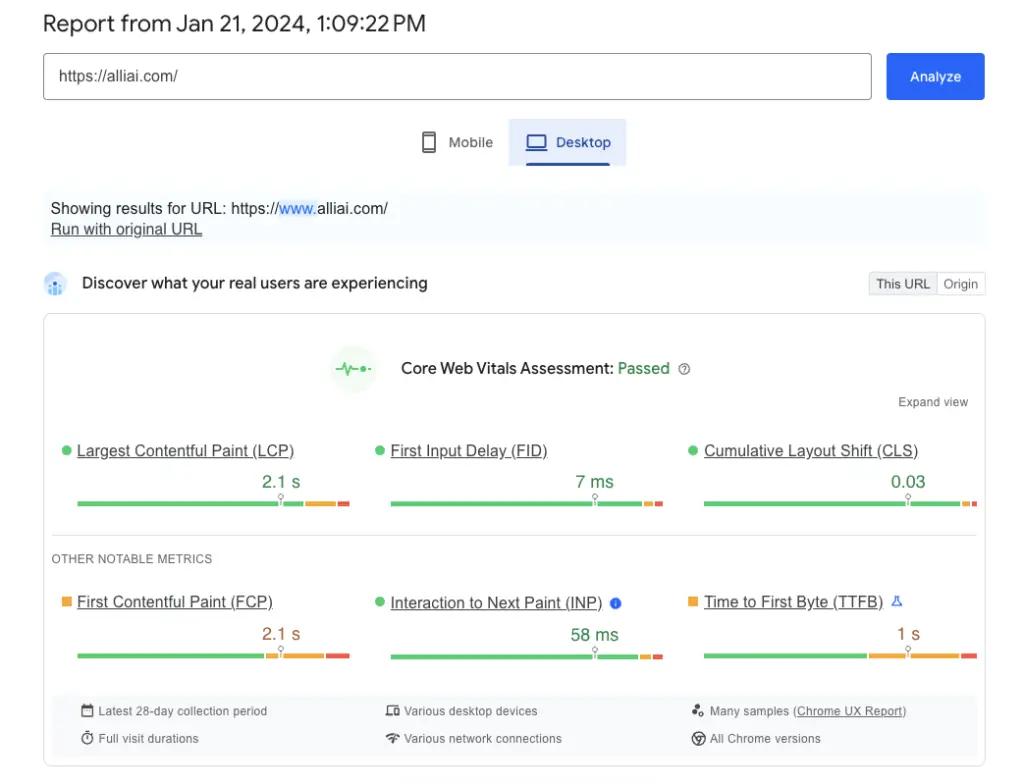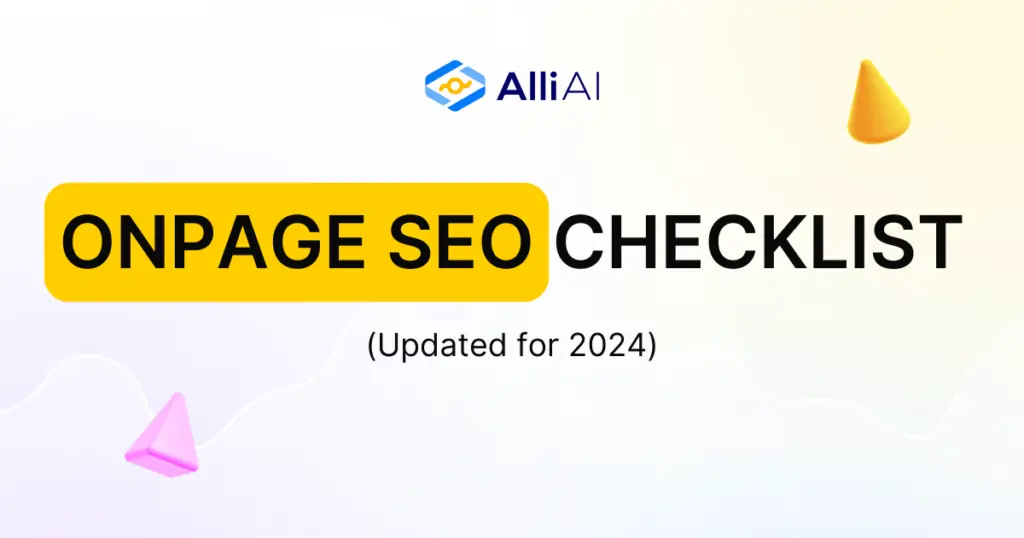In the ever-evolving world of digital marketing, search engine optimization (SEO) remains a crucial aspect of any successful online strategy. Among the various components of SEO, on-page SEO plays a vital role in enhancing your website’s visibility and credibility. By optimizing individual web pages, you can improve your site’s search engine rankings and attract organic traffic. To help you master the art of on-page SEO, we’ve compiled a comprehensive “51 Essential On-Page SEO Checks” checklist. This valuable resource is a roadmap to optimizing your website’s content and structure, ensuring it meets the best practices set by search engines like Google. By following this checklist, you can reap numerous benefits, such as:
- Improved website ranking: By adhering to on-page SEO best practices, you increase your chances of ranking higher in search engine results pages (SERPs), making it easier for your target audience to find you.
- Increased organic traffic: Higher search engine rankings lead to more organic traffic, as users are likelier to click on the top results.
- Enhanced user experience: On-page SEO focuses on making your website more user-friendly, which leads to better engagement, lower bounce rates, and increased conversions.
- Greater credibility and trust: A well-optimized website signals to search engines and users that your content is relevant, valuable, and trustworthy.
So, let’s dive in and start maximizing your on-page SEO potential! P.S.
Before we begin, you can get a copy of the checklist here.
Understanding Onpage SEO
On-page SEO, also known as on-site SEO, refers to the practice of optimizing individual web pages on a website to improve their search engine rankings and earn organic traffic. This process involves enhancing both the content and HTML source code of a page, focusing on factors that are within the website owner’s control. On-page SEO plays a significant role in the broader context of SEO strategies, as it lays the foundation for a well-optimized website. By adhering to on-page SEO best practices, you can ensure that your content is relevant, valuable, and easily accessible to both users and search engines. This, in turn, helps to establish your website’s credibility and authority, making it more likely to rank higher in search engine results pages (SERPs). To better understand the role of on-page SEO, it’s essential to differentiate it from other aspects of SEO, such as off-page SEO and technical SEO:
- On-page SEO: As mentioned earlier, on-page SEO focuses on optimizing individual web pages on a website, including content, meta tags, and HTML source code. Examples of on-page SEO techniques include keyword optimization, creating high-quality content, and improving page load times.
- Off-page SEO: Off-page SEO refers to the practices used to build a website’s reputation and authority through external factors, such as backlinks from other reputable websites. These off-site signals help search engines determine the credibility and relevance of a website, which can influence its search engine rankings.
- Technical SEO: Technical SEO involves optimizing a website’s underlying structure and foundation to improve its crawlability, indexability, and overall performance. This includes aspects like site speed, mobile-friendliness, site architecture, and XML sitemaps.
The 51-Point On-Page SEO Checklist
Keyword
Keywords play a crucial role in on-page SEO, as they help search engines understand the content of a webpage and determine its relevance to a user’s query. By optimizing your content with the right keywords, you can improve your website’s visibility and ranking in search results, ultimately driving more organic traffic. To illustrate this strategy effectively, we will be focusing on “Sports Shoes” as our primary keyword.
Identifying the Primary Keyword
The primary keyword for your content acts as a compass, guiding both focus and optimization. For a sports shoe retailer or a blog discussing athletic footwear, “Sports Shoes” is a fitting primary keyword. This choice shapes the entire narrative and optimization strategy of your content.
Understanding the Search Intent
Grasping why users search for “Sports Shoes” is crucial. Is it for buying (transactional), learning about the best sports shoes (informational), or comparing brands (navigational)? Understanding this intent is key. For instance, if the intent is primarily transactional, your content should lean toward product listings or sales pages.
Content-Type Suitability
Align your content with the search intent of “Sports Shoes”. If users are looking to purchase, a product page with a variety of sports shoes and purchase options is ideal. For those seeking information, a blog post reviewing or comparing different sports shoes would be more appropriate.
Global Search Volume
Knowing how often “Sports Shoes” is searched globally informs you of its popularity and potential to attract traffic. A high search volume indicates a strong interest, suggesting that well-optimized content could attract considerable attention.
Difficulty Level
Assessing the difficulty of ranking for “Sports Shoes” involves analyzing the competition and your site’s authority. High-competition keywords require more robust SEO strategies and possibly a longer timeframe to see significant ranking improvements.
Existing Page Rankings
Check if your site already ranks for “Sports Shoes”. If so, leverage this by updating and improving that content rather than competing against yourself with multiple pages targeting the same keyword.
Identifying Secondary/Relevant Keywords
Including related keywords like “athletic footwear”, “running shoes”, or “sports sneakers” enriches your content. This not only supports the primary keyword but also caters to a wider range of search queries.
Seasonality of the Keyword
Finally, understand if “Sports Shoes” has seasonal peaks. Perhaps searches increase just before school sports seasons or during fitness resolutions in the new year. Timing your content with these peaks can maximize visibility and traffic. You can use “Google Trends” to find the seasonality of the primary keyword.
Title
When it comes to optimizing your website for search engines, the title of your content is more than just a heading. It’s a critical factor in search engine ranking, especially when dealing with competitive keywords like “Sports Shoes.” Here’s how to perfect your title for maximum SEO impact:
Primary Keyword in Title
Ensure that your main keyword is included in the title tag. This signals to search engines that your content is relevant to the keyword and can help improve your search engine ranking.
For instance, a suitable title tag for our primary keyword could be “Best Sports Shoes for Comfort and Performance.”
Keyword Placement in Title
Place the main keyword near the beginning of the title tag to enhance its visibility and click-through rate (CTR) from search engines. Users are more likely to click on a search result if the keyword appears early in the title.
For example, “Sports Shoes: Top Picks for Comfort and Performance” would be more effective than “Top Picks for Comfort and Performance: Sports Shoes.”
Title Length Appropriateness
Keep your title tag concise, ideally between 50 to 75 characters, to avoid being truncated by Google. Shorter, clear titles are more effective for users and search engines, as they convey the content’s focus without being overly lengthy or confusing.
For instance, “Sports Shoes for Running and Training” is a concise and informative title.
Title’s Match with Search Intent
Ensure that your title tag accurately reflects what users are looking for when searching for your primary keyword. Matching the search intent increases click-through rates and user satisfaction, as users are more likely to find the content they need.
For example, if the search intent for “sports shoes” is transactional, a title like “Buy Sports Shoes Online: Best Deals and Discounts” would be appropriate.
H1 Tag for Title
Make sure that your title tag is marked as an H1 heading on the page. This signifies to search engines that it is the primary heading, which is important for the overall SEO structure of your content. In most website templates and content management systems, the title tag is automatically assigned as the H1 heading.
<h1>Expert Reviews: Top Sports Shoes of 2024</h1>Title Uniqueness and Cannibalization Avoidance
Verify that your title tag is unique across your website to prevent competition between your pages, a phenomenon known as cannibalization. Unique titles help each page rank effectively without harming the performance of other pages.
For instance, if you have separate pages for different types of sports shoes, ensure that each page has a unique and descriptive title, such as “Men’s Running Shoes: Top Picks for Comfort and Speed” and “Women’s Basketball Shoes: Best Shoes for On-Court Performance.”
URL
A URL slug is not just a web address; it’s a crucial element in SEO strategy, especially when optimizing for competitive keywords like “Sports Shoes.” Here’s how to ensure your URL slugs are primed for SEO success:
Primary Keyword in URL
Incorporating your primary keyword, “Sports Shoes,” into your URL reinforces its relevance to both users and search engines.
For example, a URL like “www.yoursportstore.com/sports-shoes” clearly indicates the content’s focus.
URL Length
Keep your URLs short and concise.
A URL like www.yoursportstore.com/sports-shoes-guide is preferable to a lengthy one like www.yoursportstore.com/2024/03/12/category/footwear/athletic/sports-shoes-buying-guide. Shorter URLs are easier to read, remember, and perform better in SEO.
Single URL for Content
Ensure that each piece of content on your site is accessible via one unique URL. This practice avoids duplicate content issues that can dilute your SEO efforts.
For instance, having both www.yoursportstore.com/sports-shoes and www.yoursportstore.com/athletic-footwear/sports-shoes pointing to the same content should be avoided.
Organized Website Structure
A well-organized website structure aids in both user navigation and search engine crawling. For a website focusing on sports shoes, categorizing products under a simple structure like www.yoursportstore.com/mens-sports-shoes or www.yoursportstore.com/womens-sports-shoes can significantly enhance SEO performance.
Avoid Yearly References in the URL
It’s advisable to avoid using specific years in your URLs.
Instead of www.yoursportstore.com/sports-shoes-2024, opt for a more evergreen URL like www.yoursportstore.com/latest-sports-shoes. This keeps the URL relevant for longer periods.
Canonical URL Check
Finally, ensure that each page has a canonical URL tag. This tag tells search engines which version of a URL is the master or preferred one, thus avoiding duplicate content issues.
For instance, if your content about sports shoes is accessible via multiple URLs, choose one primary URL and set it as the canonical address, like
<link rel="canonical" href="www.yoursportstore.com/sports-shoes"/>.
Meta Descriptions
Crafting an effective meta description is an essential aspect of on-page SEO, as it provides search engines with a summary of the content and influences users’ decision to click through to your website. In this section, we’ll discuss the best practices for creating an optimized meta description.
Meta Description Length
Keep your meta description concise, ideally between 100 to 150 characters. A short meta description is more effective for SEO and user readability, as it ensures that the entire description is displayed in search engine results without being truncated.
For instance, a suitable meta description for our primary keyword could be: “Discover the best sports shoes for comfort and performance. Shop our collection of running, basketball, and training shoes today.”
Primary Keyword in Meta Description
Include the main keyword in the meta description to align it with search queries and enhance its SEO relevance. This signals to search engines that the content is relevant to the keyword and can help improve your search engine ranking. Additionally, including the keyword in the meta description can make it bold in search engine results, drawing users’ attention and increasing click-through rates.
For example: “Find the perfect sports shoes for your needs. Explore our wide selection of running, basketball, and training shoes for men and women.”
Uniqueness of Meta Description
Ensure that each page on your website has a unique meta description to prevent confusion and improve each page’s SEO value. Unique meta descriptions help search engines understand the distinct content of each page and can increase click-through rates by providing users with accurate and relevant information. For instance, if you have separate pages for different types of sports shoes, ensure that each page has a unique and descriptive meta description, such as:
- Running Shoes: “Experience unmatched comfort and performance with our top-rated running shoes for men and women. Shop now and elevate your running game.”
- Basketball Shoes: “Dominate the court with our selection of high-performance basketball shoes for men and women. Discover the perfect fit today.”
- Training Shoes: “Achieve your fitness goals with our versatile training shoes for men and women. Shop our collection and find the ideal shoe for your workout.”
Image
Optimizing images is an essential aspect of on-page SEO, as it improves page load times, enhances user experience, and increases the likelihood of ranking higher in search engine results pages. In this section, we’ll discuss the best practices for optimizing images.

Image Compression for Faster Page Speed
Ensure that your images are compressed to reduce load times and enhance user experience. Slow-loading pages can negatively impact SEO performance and user engagement. You can use various tools, such as TinyPNG or ImageOptim, to compress your images without compromising their quality. Compressing a detailed image of the latest sports shoe model from 5MB to 500KB can drastically improve page speed, positively impacting SEO and user experience.
Primary Keyword in Image Title
Include the main keyword in the image title to align it with relevant search queries and boost SEO. This helps search engines understand the content of the image and can improve its visibility in image search results.
For instance, instead of naming an image file “IMG_001.jpg,” name it “latest-sports-shoes-2024.jpg.” This simple change can significantly enhance the image’s relevance in search engine algorithms.
Contextual Primary Keyword in Alt Text
Use the primary keyword in the image’s alt text in a relevant way to improve SEO and accessibility for the image. Alt text is a description of the image that is displayed when the image cannot be loaded or is accessed by screen readers used by visually impaired users. By including the primary keyword in the alt text, you can provide context and improve the image’s SEO value.
For example, an appropriate alt text for an image of a pair of running shoes could be “Men’s lightweight running shoes for improved performance” or “Women’s basketball shoes with superior ankle support.”
Uniqueness of Images (Avoid Stock Images)
Opt for unique images over stock photos to enhance user engagement and contribute positively to SEO. Unique images can help your content stand out and provide a more authentic and engaging user experience. While stock images can be useful in certain situations, they may not always accurately represent your products or services and can appear generic.
For instance, instead of using a stock photo of a pair of sports shoes, consider taking high-quality photos of the actual products you offer or creating custom graphics that showcase the unique features of your sports shoes.
Links
Adding relevant and optimized links is an essential aspect of on-page SEO, as it helps guide users and search engines to related content, adds credibility to your content, and improves user experience. In this section, we’ll discuss the best practices for adding links
Relevant Internal Links Added
Add internal links that are relevant to the content and guide users and search engines to related content on your site. This helps improve user engagement, reduce bounce rates, and distribute link equity across your website.
For instance, if you have a blog post about the benefits of running shoes for athletes, you could add internal links to related content, such as “How to Choose the Right Running Shoes for Your Foot Type” or “The Top 10 Running Shoes for Marathon Runners.”
Optimized Anchor Text for Internal Links
Use relevant keywords in the anchor text of internal links to enhance SEO and make the link’s purpose clear to users. Anchor text is the clickable text that users see when they hover over a link. By using descriptive and relevant keywords in the anchor text, you can provide context and improve the link’s SEO value.
For example, instead of using “click here” as the anchor text for a link to a page about basketball shoes, use “best basketball shoes for men” or “women’s basketball shoes for improved performance.”
Adding External Links to Relevant Content
Include external links to authoritative content, such as statistics, quotes, or research, to add credibility and depth to your content. External links can help support your claims, provide additional resources for users, and improve your content’s overall quality.
For instance, if you have a blog post about the benefits of wearing sports shoes for fitness, you could include external links to research studies or articles that support your claims, such as “The Benefits of Wearing the Right Shoes for Exercise” or “How the Right Shoes Can Improve Your Workout Performance.”
Placement of External Links
Avoid placing external links at the very beginning of your content, as this can distract users from engaging with your content and reduce the likelihood of them returning to your site. Instead, place external links strategically throughout your content, such as in the middle or towards the end, to provide additional resources and support your claims without detracting from the user experience.
External Links Opening in New Tab
Set external links to open in a new tab to improve user experience by keeping your page accessible. It’s as simple as adding target="_blank" in your HTML link tag. This allows users to easily return to your content after viewing the external link and can reduce bounce rates.
For example, if you have a link to an external article about the benefits of wearing sports shoes for fitness, set it to open in a new tab so that users can easily return to your content after reading the article.
User Experience
In the competitive world of online sports shoe retailing, user experience (UX) is not just a nicety—it’s a necessity. A website that’s easy to navigate, fast, and accessible can significantly improve your SEO and keep customers coming back. Let’s explore the key aspects of UX that every “Sports Shoes” website should consider:
Mobile Friendliness
With more and more users accessing the internet on their mobile devices, it’s essential to ensure that your sports shoes website is mobile-friendly. This means that your website should be optimized for smaller screens, with easy-to-read text, large buttons, and intuitive navigation. You can use tools like Google’s Mobile-Friendly Test to check if your website is mobile-friendly and identify any areas that need improvement.
Inclusion of Breadcrumbs
Breadcrumbs are essential for a seamless shopping experience. They help users navigate your website, especially in a complex product category like sports shoes.
For example, a breadcrumb trail like Home > Men’s Footwear > Sports Shoes > Running Shoes offers clear navigational paths. This clear path guides users back to broader categories and improves the overall navigability of your site, enhancing UX and SEO by making your site more user-friendly and easier to crawl by search engines.
Web Accessibility Compliance (W3C)
Following W3C accessibility principles ensures your site is accessible to all users, including those with disabilities. This could mean having text alternatives for images, ensuring screen reader compatibility, and providing easy keyboard navigation. An accessible website not only broadens your audience but also improves your SEO, as search engines favor websites that are accessible to all users.
Popups and Interstitials Management
While popups and interstitials can be useful for capturing user information or promoting products, excessive use can lead to user frustration and potential SEO penalties. Limit the use of popups and interstitials on your sports shoes website and ensure that they are easy to close and don’t interfere with the user experience.
Relevant Schema Markup
Implementing schema markup, such as FAQ or How-To formats, can greatly benefit your “Sports Shoes” website.
For instance, using FAQ schema for common questions about shoe sizes or return policies, or How-To schema for guides on cleaning sports shoes, can help search engines understand and display your content more effectively. This not only improves search visibility but also provides users with quick, relevant information directly in search results.
Core Web Vitals Compliance
Ensuring your website meets Google’s Core Web Vitals – focusing on loading performance, interactivity, and visual stability – is crucial. For a “Sports Shoes” website, this means fast loading times for high-quality images of shoes, interactive elements like size selectors working smoothly, and maintaining layout stability during page loading. Meeting these vitals enhances user experience, which is directly linked to improved SEO performance.

Check for Broken Links
Broken links can be frustrating for users and can negatively impact your site’s credibility. Regularly checking for and fixing broken links can help maintain the integrity of your sports shoe website and improve user experience. Using tools like Google Webmaster can help identify and fix these links, maintaining site integrity and ensuring a smooth user journey.
Valid SSL Certificate
An SSL certificate encrypts data transmitted between the user’s browser and your website, protecting sensitive information like credit card numbers and login credentials. It also instills trust in your users when they see the padlock symbol in the browser bar, apart from being a ranking factor for search engines. You could use a tool like SSL Labs to check the validity of your SSL certificate and ensure that it’s up to date.
User-Friendly Buttons and Links
Making sure that buttons and links are easily identifiable and clickable can improve user experience and make it easier for users to navigate your website. This includes clear call-to-action (CTA) buttons like “Buy Now” for a pair of sports shoes, or “Read More” on a blog post about the latest sports shoe technology. Good button design and placement can greatly enhance the user’s shopping experience and guide them smoothly through the purchasing process.
Verify External JavaScript Impact on Page Load
External JavaScript, while useful for adding functionality, can slow down your page load times. Since speed is a critical factor in both user experience and SEO, it’s important to assess and optimize the impact of these scripts. You could use a tool like Google’s PageSpeed Insights to identify any external JavaScript files that are slowing down your site’s load time and take steps to optimize them. For a “Sports Shoes” website, where users expect quick access to product listings and reviews, ensuring that external scripts do not hinder page load is crucial.
Browser Compatibility
Lastly, check that your website performs well across all commonly used browsers, like Chrome, Firefox, Safari, and Edge, as well as on different devices and operating systems. This ensures all potential customers have a consistent and positive experience, regardless of how they access your site. Browser compatibility issues can lead to distorted layouts or non-functional elements, negatively impacting the user experience and potentially hurting SEO. You could use a tool like BrowserStack to test your website’s compatibility across different browsers and devices.
Content
When developing content for your website, it’s not just about what you say, but how you present it. Structuring your content effectively is key to both engaging your readers and optimizing for search engines. Here’s how to do it:
Structured Headings Format (H2, H3, H4, etc.)
A clear hierarchy of headings (H2, H3, H4, etc.) is crucial for organizing content and enhancing readability. For a comprehensive article on “Sports Shoes,” start with an H2 heading like “The Ultimate Guide to Sports Shoes,” followed by H3 subheadings for specific topics such as “Choosing the Right Sports Shoes for Your Needs” or “Top Sports Shoes Brands in 2024.” This structured format helps readers easily navigate through the content and enables search engines to better understand the layout and emphasis of your content.
Primary Keyword in a Heading
Incorporate “Sports Shoes” into at least one heading to signal its relevance to search engines. An H2 heading like “Sports Shoes: Trends for the Upcoming Season” clearly shows the main focus of the content, improving topic relevance and SEO.
Natural Keyword Integration
While it’s important to include primary and secondary keywords, they should be integrated naturally into your content.
For instance, instead of forcefully repeating “Sports Shoes” to the point of redundancy, use it meaningfully, like “When it comes to sports, having the right footwear can make all the difference. A good sports shoe can provide the support, cushioning, and traction you need to perform at your best, while a poorly fitting or inappropriate shoe can lead to discomfort, injury, or poor performance.” This approach maintains the quality of the content and avoids the pitfalls of keyword stuffing.
Author Section
Adding an author section contributes to the credibility of your content. If the piece is written by a sports footwear expert or a seasoned athlete, mentioning their background and experience can greatly enhance the content’s EEAT (Experience, Expertise, Authoritativeness, Trustworthiness).
For example, an author bio like “John Doe, with over 10 years of experience in athletic footwear design, shares his insights on the latest trends in sports shoes” can lend considerable weight to the article.
Author Archive
Creating an archive for authors adds a layer of credibility and supports EEAT (Experience, Expertise, Authoritativeness, Trustworthiness) compliance. For a “Sports Shoes” blog or eCommerce site, having a dedicated section where readers can access all articles written by a specific author, especially if they are experts in athletic footwear or sports, can greatly enhance the site’s credibility.
For example, an author profile for “Jane Smith, Footwear Specialist” with links to her articles like “Innovations in Sports Shoes Technology” or “Guide to Choosing the Right Sports Shoes” can establish authority in the niche.
Comprehensive Coverage of Topic
When it comes to sports shoes, it’s important to avoid thin content and thoroughly cover your topic for depth and value. This means providing comprehensive information on the different types of sports shoes available, their features, benefits, and how to choose the right one for your needs. By providing in-depth and valuable content, you can establish your website as a trusted source of information and improve your search engine rankings.
For example, your sports shoe blog might include sections like:
- Types of Sports Shoes: This section could cover the different types of sports shoes available, such as running shoes, basketball shoes, tennis shoes, and cross-training shoes. You could provide detailed information on the features and benefits of each type of shoe, as well as the types of activities they are best suited for.
- How to Choose the Right Sports Shoe: This section could provide tips and advice on how to choose the right sports shoe for your needs. You could cover topics like how to determine your foot type, what to look for in a sports shoe, and how to properly fit a sports shoe.
- Sports Shoe Reviews: This section could provide in-depth reviews of popular sports shoes, including their features, benefits, and drawbacks. You could also provide comparisons between different types of shoes to help your audience make informed decisions.
Content Matching Search Intent
To ensure that your sports shoe content is effective and engaging, it’s important to align it with the search intent of your target audience. This means understanding what your audience is looking for when they search for sports shoes and providing content that meets their needs.
For example, if your target audience is looking for information on how to choose the right running shoe, your content should focus on providing detailed information on this topic. You might include sections like:
- How to determine your foot type
- The importance of proper fit and support
- The different types of running shoes available and their features
- Tips for trying on and testing running shoes
Accuracy and Originality of Content
To establish credibility and uniqueness, it’s essential to focus on creating accurate and original content for your sports shoe blog. This means conducting thorough research, fact-checking your information, and providing unique insights and perspectives.
For example, you might conduct original research on the impact of sports shoes on athletic performance, or interview top athletes and shoe designers to provide unique insights into the world of sports footwear. By providing accurate and original content, you can establish your website as a trusted source of information and improve your search engine rankings.
Alli AI: Better Approach
If you’re managing a large website with hundreds or even thousands of pages, doing on-page SEO checks manually can be a daunting and time-consuming task. Not only is it labor-intensive, but it’s also prone to errors and inconsistencies. So, is there a better approach to doing these on-page SEO checks manually across hundreds of pages? The short answer is yes. Automating your on-page SEO checks can save you time, reduce errors, and improve the consistency of your optimization efforts. Here are some reasons why:
- Consistency: When you’re manually optimizing hundreds of pages, it’s easy to miss things or make mistakes. Automating your on-page SEO checks ensures that every page is optimized consistently and accurately, with no errors or oversights.
- Time-saving: Manually optimizing hundreds of pages can take weeks or even months. Automating your on-page SEO checks can significantly reduce the time it takes to optimize your website, freeing up your time to focus on other important tasks.
- Scalability: As your website grows, manually optimizing each new page becomes increasingly difficult and time-consuming. Automating your on-page SEO checks allows you to scale your optimization efforts quickly and easily, without having to add more resources.
- Improved accuracy: Automated on-page SEO checks can analyze your website’s data more accurately and quickly than a human can. This means you can identify issues and opportunities more quickly and make data-driven decisions about your optimization efforts.

So, how can you automate your on-page SEO checks? There are several tools and platforms available that can help you do this, including our SEO automation platform. Our platform uses AI and machine learning algorithms to analyze your website’s data and identify opportunities for optimization. It can automatically generate and implement on-page SEO recommendations, such as optimizing title tags, meta descriptions, and header tags. It can also identify technical SEO issues, such as broken links and duplicate content, and provide recommendations for fixing them. Some of our features include:
- Bulk Onpage Optimization: Our bulk onpage optimization feature is designed for seamless and efficient SEO management. It allows users to automate and implement widespread on-page code optimizations across their websites. This feature is handy for handling large-scale changes quickly and effectively. By integrating with any CMS, Alli AI simplifies the process of optimizing numerous pages, ensuring consistency and improved SEO performance across your entire site.
- Live Editor: It allows real-time, direct editing of website content for SEO optimization. This tool provides an intuitive interface, making it easy for users to make changes to their site without needing to navigate complex code or back-end systems. It’s especially useful for quickly tweaking and testing various SEO elements like metadata, headers, and body content.
- Real-Time Deployment: It enables instant deployment of changes, bypassing CMS and technical limitations. This allows SEOs to make on-page changes quickly and efficiently, with no waiting on tickets or pull requests. It’s an ideal solution for marketers and website owners seeking immediate improvements in their site’s SEO performance.
- Automated A/B Testing: It allows for real-time, automated SEO A/B testing to maximize ROI. The AI writes self-optimizing, target keyword-rich titles that self-adjust to algorithm and rankings changes to maximize each page’s traffic potential, all automated. This feature is used by over 20,000 companies and can optimize any website automatically, showing the links needed to rank and helping to get it done.
- Schema Markup: It instantly generates and implements the best Schema Markup for all your pages, bypassing the need for manual implementation and coding. This feature enhances search engine understanding, resulting in higher visibility in search results and improved user experience. Alli AI’s AI-driven approach ensures accurate, relevant, and aligned Schema Markup with the latest schema.org guidelines, increasing the chances of search engines recognizing your website’s value.
- Interlinks: It intelligently suggests relevant internal links within a website’s content, facilitating improved site structure and navigation. This tool is particularly valuable for boosting the SEO value of a website by strengthening internal link connectivity, which can positively impact search engine rankings.
Our SEO automation platform is designed to streamline and automate your on-page SEO efforts, saving you time and improving your website’s search engine rankings. Try it out today and see the difference it can make for your website’s performance.
Frequently Asked Questions
What is onpage SEO?
On-page SEO refers to the practice of optimizing individual webpages on a website to rank higher and earn more relevant traffic in search engines. This includes optimizing elements such as title tags, meta descriptions, header tags, and content to improve relevance and user experience.
What is an off-page SEO?
Off-page SEO refers to the practice of optimizing external factors that impact a website’s search engine rankings, such as backlinks from other websites. This involves building a website’s authority and credibility in the eyes of search engines by earning high-quality, relevant links from other reputable sources.
What is the difference between off-page SEO and onpage SEO?
On-page SEO is about optimizing content and HTML source code, while off-page SEO is about building relationships and earning links from other websites. Both on-page and off-page SEO are crucial for a successful SEO campaign, and they work together to achieve higher search engine rankings, increased traffic, and conversions.






